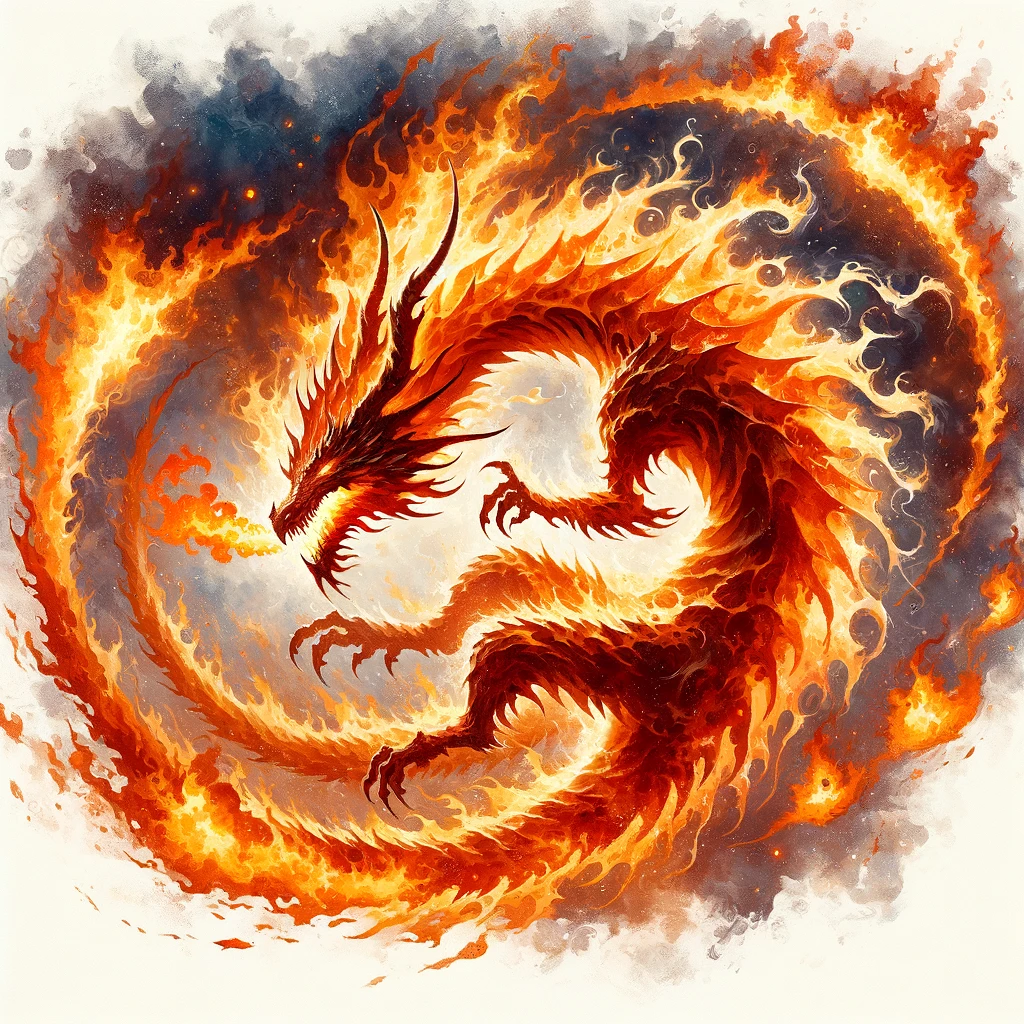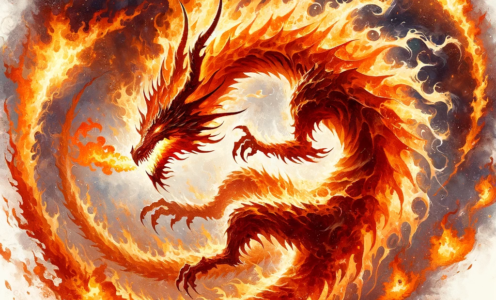Wildfire Dragon
Also called fire dragons, firestorm dragons
| CLIMATE/TERRAIN: | Elemental Fire, volcanoes |
| FREQUENCY: | Very rare |
| ORGANISATION: | Solitary |
| ACTIVITY CYCLE: | Any |
| DIET: | Special |
| INTELLIGENCE: | Genius (17-18) |
| TREASURE: | Special |
| ALIGNMENT: | Varies |
| NO. APPEARING: | 1 (2-5) |
| ARMOUR CLASS: | -6 (base) |
| MOVEMENT: | 12, Fly 35 (C), Jump 3 |
| HIT DICE: | 10 (base) |
| THAC0: | 3 (at 18 HD) |
| NO. OF ATTACKS: | 3 + special |
| DAMAGE/ATTACK: | 2d10 / 2d10 / 5d12 |
| SPECIAL ATTACKS: | See below |
| SPECIAL DEFENCES: | See below |
| MAGIC RESISTANCE: | See below |
| SIZE: | G (65′ base) |
| MORALE: | Fanatic (17-18) |
| XP VALUE: | See below |

Wildfire dragons are deadly creatures, born of elemental flame and all-consuming in nature. They’re mesmerising beasts to watch; their bodies flicker and dance in an almost hypnotic pattern. Physically, they appear similar in shape to red dragons, their distant ancestors, but rather than being made of solid flesh, their scales are pure flame. Wildfire dragons are also fiery-tempered. They are quick to take action, whether it be a friendly gesture or a deadly attack.
Wildfire dragons speak their own language, the language of fire elementals, and a language common to all catastrophic dragons. When born, there is a 13% chance that the dragon can communicate with all sentient creatures. This chance increases by 4% per age category.
COMBAT: Wildfire dragons fight efficiently and mercilessly. They know they are powerful, and they use that power to their advantage. Wildfire dragons often like to attack with their breath weapon before moving into physical combat. When fighting creatures that seem useful or who could possess useful information, they prefer to use their fire charm ability to soften them up first.
BREATH WEAPON/SPECIAL ABILITIES: A fire dragon’s breath weapon is a cone of elemental fire, 90′ long, 5′ wide at the dragon’s mouth and 30′ at the base.
- Wildfire dragons are born immune to energy draining and electricity. They take double damage from cold or water attacks (easier said than done on the Plane of Fire, however). When attacked with fire, they actually gain a number of hit points equal to the number of hit dice the attack would have inflicted. For example, a 12th-level mage casts a fireball, which would normally do 12d8 damage. The fire dragon gains 12 hit points instead of taking damage.
- Any being that comes into physical contact with a wildfire dragon takes Xd8 points of damage, where X is equal to the dragon’s age category. A successful save vs. breath weapon can halve this damage, and immunity and resistance to fire can also reduce this damage. When a being not immune to fire or heat comes within 30′ of the dragon, they take 1d4 points of damage per age category of the dragon. Once within 30′, anything combustible must make a successful saving throw or catch fire.
- A fire dragon cast spells and uses its magical abilities at 16th-level plus its combat modifier.
- As they age, they gain the following additional abilities: Very Young: Fire charm at will. Young: Burning hands three times per day. Juvenile: Fireball three times per day. Adult: Flame strike three times per day. Mature Adult: Delayed blast fireball three times per day. Old: Meteor swarm three times per day. Very Old: Summon fire elemental three times per day.
HABITAT/SOCIETY: Wildfire dragons very rarely leave their home on the Elemental Plane of Fire, except to reproduce. Those that do normally make their homes in active volcanoes and lava flows. In their home plane wildfire dragons use their innate magic to build lairs from solid fire. They are solitary creatures, but some establish an entourage of flame drakes and blazewyrms.
Most (50%) of fire dragons are neutral. The rest are evenly split between good and evil (25% chance of either). Of these dragons, roughly 40% are neutral, and the rest lawful or chaotic (30% chance of either).
ECOLOGY: Wildfire dragons sustain themselves on flames and heat, very rarely actually eating something. However, they do this when they are young and need to grow, or when they are injured and have to heal. Even in such vulnerable conditions wildfire dragons are uncontested apex predators, easily preying on fire whales and flame drakes. They hate tsunami and glacier dragons and will attack them on sight (although the species rarely encounter each other).
Wildfire dragons can be extremely damaging to the life surrounding their lair (unless they’re on the Plane of Fire, of course!). When they leave the lair, their extreme body temperature can ignite dry wood as far as 30′ away. They can easily start forest or brush fires, destroying an ecosystem within a matter of hours. Fire dragons love doing this, although permanent forest fires in one area tend to be a bit of a giveaway that something odd is going on… But all of this damage is by design. Fires set ablaze by a wildfire dragon leave behind not only ashes, but also dragon eggs, from which new wildfire dragons hatch. These little wyrmlings need a few months to grow, before they can start a wildfire large enough to open the vortex back to Crematorium.
Chant goes that the efreet have a platoon of wildfire dragons guarding their City of Brass. Considering that the efreet hate wildfire dragons as much as they do any other creature, and that the feeling’s entirely mutual, it’s likely that these dragons are enslaved somehow. Djinn legends also tell of wildfire dragons with efreet riders; a lethal combination of malevolent force. Fortunately nobody seems to have seen anything like this for hundreds of years, but those rumours always have a habit or resurfacing.
| Age Category | Body (‘) | Tail (‘) | AC | Breath Weapon | Wizard/Priest Spells | MR | Treasure | XP Value |
| 1 | 15-27 | 14-25 | -3 | 4d12+1 | Nil | Nil | Nil | 18,000 |
| 2 | 27-39 | 25-36 | -4 | 6d12+2 | Nil | Nil | Nil | 19,000 |
| 3 | 39-51 | 36-46 | -5 | 8d12+3 | Nil | 35% | E, S, T | 20,000 |
| 4 | 51-58 | 46-58 | -6 | 10d12+4 | 1 | 40% | H, S, T | 22,000 |
| 5 | 58-75 | 58-68 | -7 | 12d12+5 | 2 | 45% | H, S, T | 23,000 |
| 6 | 75-88 | 68-78 | -8 | 14d12+6 | 2 2 | 50% | H, S, Tx2 | 24,000 |
| 7 | 88-101 | 78-92 | -9 | 16d12+7 | 2 2 2 | 55% | H, S, Tx2 | 25,000 |
| 8 | 101-114 | 92-103 | -10 | 18d12+8 | 2 2 2 2 / 1 | 60% | H, S, Tx2 | 27,000 |
| 9 | 114-128 | 103-116 | -11 | 20d12+9 | 2 2 2 2 2 / 2 | 65% | H, S, Tx3 | 28,000 |
| 10 | 128-142 | 116-128 | -12 | 22d12+10 | 2 2 2 2 2 2 / 2 2 | 70% | H, S, Tx3 | 29,000 |
| 11 | 142-156 | 128-141 | -13 | 24d12+11 | 2 2 2 2 2 2 2 / 2 2 2 | 80% | H, S, Tx3 | 31,000 |
| 12 | 156-170 | 141-154 | -14 | 26d12+12 | 2 2 2 2 2 2 2 1 / 2 2 2 2 | 85% | H, S, Tx4 | 33,000 |

Source: John Kastronis, Jon Winter-Holt, Margarita. Canonwatch: These creatures were originally called ‘elemental fire dragons’ which is pretty dull. I’ve adopted the 4e name ‘wildfire dragon’, which comes from Dragon Magazine #424-425 about catastrophic dragons, although the remainder of the entry has remained the same.

